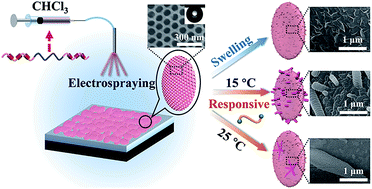Pillararene-based supramolecular membranes with the rose-petal effect and nanostructure-modulated tunable water adhesion†
Abstract
The ability to craft supramolecular membranes with the rose-petal effect in a simple yet rapid manner represents an important endeavor towards creating functional materials and devices for use in anti-icing, controlled transportation of fluids, material coating, etc. Herein, we report a robust strategy for crafting a pillararene-based supramolecular membrane possessing the rose-petal effect via judiciously integrating electrospraying with the breath figure approach. Specifically, polypseudorotaxane (PPR), a complex of an amphiphilic triblock copolymer (PCL-b-PEG-b-PCL) and 1,4-diethoxypillar[5]arene (DEP5A), is designed and subsequently exploited for creating such a smart membrane. Notably, the membrane comprises multi-layered honeycomb nanosheets (denoted as HNM) with an average pore size of approximately 80 nm and is promising for trace liquid transportation and material coating. Furthermore, the swelling of the amphiphilic copolymer in ethanol and the competitive guest-responsiveness of PPR enable the formation of the folded nanosheet membrane (FNM), the papillae-nanosheet membrane (PNM) and the leaf-nanosheet membrane (LNM) from the HNM, respectively. Intriguingly, despite the fact that all the membranes exhibit superhydrophobicity, the FNM, PNM and LNM manifest significantly different water adhesion forces compared to the HNM. These results reveal that the water adhesion forces of these membranes depend heavily on the surface roughness induced by the nanostructures of the nanosheets.



 Please wait while we load your content...
Please wait while we load your content...